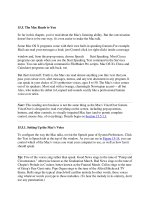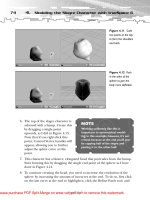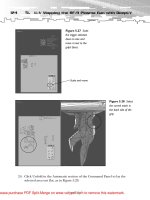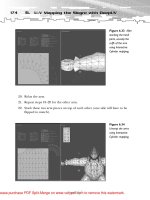Tài liệu The UML and Data Modeling pptx
Bạn đang xem bản rút gọn của tài liệu. Xem và tải ngay bản đầy đủ của tài liệu tại đây (481.13 KB, 11 trang )
T
T
h
h
e
e
U
U
M
M
L
L
a
a
n
n
d
d
D
D
a
a
t
t
a
a
M
M
o
o
d
d
e
e
l
l
i
i
n
n
g
g
A Rational Software Whitepaper
Table of Contents
Introduction....................................................................................................................1
The UML Data Modeling Profile ..................................................................................1
Database .....................................................................................................................1
Schema .......................................................................................................................2
Table...........................................................................................................................2
Key .............................................................................................................................3
Index...........................................................................................................................4
Relationship................................................................................................................5
Column.......................................................................................................................6
Datatype .....................................................................................................................6
Constraint...................................................................................................................6
Summary........................................................................................................................8
The UML and Data Modeling
1
Introduction
The power of the Unified Modeling Language is not limited to object oriented software development.
More and more, the UML is being applied to other areas of software development, such as data
modeling, enhancing practitioners’ ability to communicate their needs and assessments to the rest of
the team.
Data analysts primarily gather data out of documented business requirements. The database itself
traditionally has been described by notations called entity relationship diagrams, using graphic
representation that is similar but not identical to that of the UML.
The UML can be used to describe the complete development of relational and object relational
databases
1
from business requirements through the physical data model. However, modeling of the
physical data model must express a detailed description of the database. This is done using Rational’s
Data Modeling Profile for the UML
2
.
The UML Data Modeling Profile
This white paper describes in detail the Data Modeling profile for the UML as implemented by
Rational Rose Data Modeler, including descriptions and examples for each concept including
database, schema, table, key, index, relationship, column, constraint and trigger. It is written for those
who have experience in traditional data modeling as well as some familiarity with the UML.
Database
The Database is the system for data storage and controlled access to stored data. It is the biggest
element a data model supports.
The relational database is the standard database supported by the Data Modeling UML profile. An
object relational database, an extension of the relational database, is also supported by the UML profile.
The stereotype <<Database>>, when used as a UML component, defines a database. As a component
the database must have a name.
In the component view, a database is a target dependent element, since it references a database type.
A corresponding icon can represent the stereotype as shown in Figure 1.
Figure 1
1
Object oriented databases are supported by UML through modeling of persistent classes.
2
Data Modeling Profile for UML is not yet approved by OMG.
The UML and Data Modeling
2
The 3 possible representations of a Database component are shown in Figure 2.
Figure 2
Schema
The full description of the data model to be used for retrieval and storage of data is stored in a schema
inside of a database. The schema is the biggest unit that can be worked with at any given time .
A package using the <<Schema>> stereotype in a UML model represents a database schema.
In a browser, a schema is shown as a package. (Figure 3)
Figure 3.
In a diagram, the representation is a package with the Schema stereotype. (Figure 4)
Figure 4.
Note that there can be more than one schema associated to a database.
Table
A table is the basic modeling structure of a relational database. It represents a set of records of the same
structure, also called rows. Each of these records contains data. The information about the structure of a
table is stored in the database itself.
A class with the <<Table>> stereotype represents a relational table in a schema of a database.
The UML and Data Modeling
3
In the browser a table is represented by a table symbol. (Figure 5)
Figure 5
The representation in a diagram uses the Table stereotype and stereotype icon. (Figure 6)
Figure 6
Hosting the table in the schema package creates the association of a table to a schema.
Key
Keys are used to access the table. Primary keys uniquely identify a row in a table, while foreign keys
access data in other related tables.
The key is represented as a key constraint and as a tagged value on the column.
A primary key uses a PK tag in front of the column as shown. (Figure 7)
Figure 7









